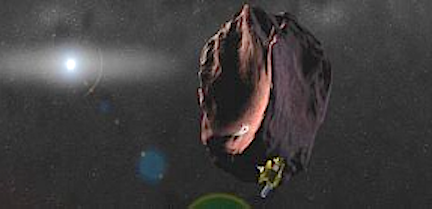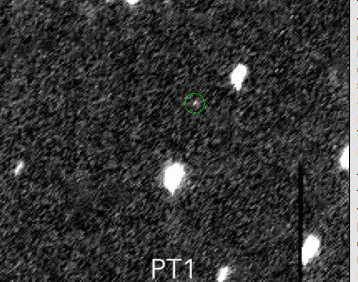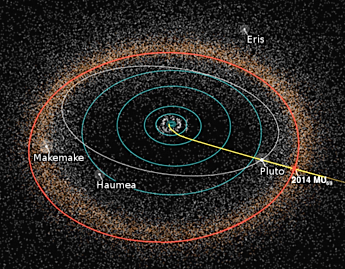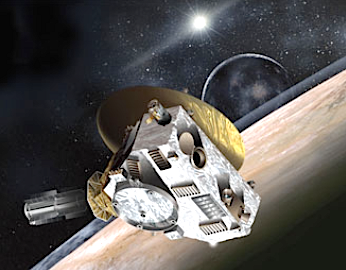A year and a half after its historic flyby of dwarf planet Pluto, NASA’s New Horizons spacecraft is preparing for its encounter with a second Kuiper Belt Object. Now just two years away from the planned January 1, 2019 encounter with 2014 MU69, New Horizons is in a healthy state as it sails toward the small, rocky, classical Kuiper Belt Object.
2014 MU69 – a new target for New Horizons:

2014 MU69 – a new target for New Horizons: Images: NASA, Johns Hopkins University, Applied Physics Laboratory, Southwest Research Institute, Alex Parker, ESA, and the New Horizons KBO Search Team
Kuiper Belt Object (KBO) 2014 MU69 – located approximately 1.6 billion km (1 billion mi) beyond Pluto – was discovered by the Hubble Space Telescope on 26 June 2014 during a dedicated survey of the sky and portion of the Kuiper Belt along New Horizons’ post-Pluto trajectory to find potential targets for the craft to encounter after Pluto.
The post-launch search for another flyby target for New Horizons was designed to maximize the science return from the mission in the far and difficult to resolve region of our solar system and to satisfy a Decadal Survey recommendation that any mission to Pluto not only investigate that world but as many others as possible in the Kuiper Belt.
To this end, the Hubble Space Telescope was employed in the search for a new Kuiper Belt flyby target because of its high precision observation capability, ability to resolve objects with high apparent magnitudes that are not visible to Earth-based telescopes, and its ability to provide reliable orbit determinations of any objects discovered.
When 2014 MU69 was discovered, it was initially labeled 1110113Y, with a nickname “11”, and was announced by NASA as a potential post-Pluto target for New Horizons in October 2014 – receiving the internal label PT1 (Potential Target 1) by NASA.

The object did not receive its official designation of 2014 MU69by the Minor Planet Center until March 2015 after sufficient orbital information had been computed via multiple observations of the body.
The designation of 2014 MU69 is, in fact, itself a provisional designation and indicates that the object was the 1,745th object discovered between 16 and 30 June 2014.
Based on current observations, 2014 MU69 is understood to be in a 295 Earth-years orbit with an aphelion of 45.86 AU and a perihelion of 42.69 ±0.04 AU – with a semi-major axis of 44.28 AU and an orbital eccentricity of 0.0358 ±0.001.
The object’s orbit is inclined 2.4532 degrees ±0.0002 degrees to the ecliptic plane (Earth’s orbital plane as defined by the path of the Sun on the sky) and carries a longitude of ascending node (the angular position of a celestial body as it travels across the reference plane as measured from a reference point on the ecliptic plane) of 158.933 degrees ±0.007.
Moreover, 2014 MU69 has an argument of perihelion (the angular distance from the ascending node to the perihelion measured in the orbit plane) of 179.9 degrees ±1 degrees and is currently understood to be between 25 – 45 km (15.5 – 28 mi) in diameter and is observed to have an apparent magnitude of 26.8 and an absolute magnitude of 10.9 – with ranges for its assumed albedo being 0.04 – 0.15.
Moreover, the low inclination and low eccentricity of the object’s orbit indicate that 2014 MU69 is a cold, classical KBO that is unlikely to have experienced significant perturbations over the course of its existence.

New Horizons preparations and observations:
Following the historic flyby of Pluto, the New Horizons team began preparing the spacecraft for a potential encounter with another KBO.
At the time of the Pluto encounter, two potential KBOs for a post-Pluto flyby remained of the initial four potential targets.
Those two remaining targets, PT1 and PT3, were both easily accessible given New Horizons’ remaining trajectory-adjustment fuel supply, though PT3 was actually the more preferred object from a scientific perspective.
Nonetheless, PT3 would have required nearly all of the trajectory-adjustment fuel supply aboard New Horizons – which would have left little fuel for adjustment maneuvers based on then unforeseen events.
Therefore, on 28 August 2015, NASA and the New Horizons team officially selected PT1 – 2014 MU69 – as the primary flyby target, while also allowing New Horizons to study nearly 20 KBOs from greater distances.
“2014 MU69 is a great choice because it is just the kind of ancient KBO, formed where it orbits now, that the Decadal Survey desired us to fly by,” said New Horizons Principal Investigator Alan Stern.
“Moreover, this KBO costs less fuel to reach, leaving more fuel for the flyby, for ancillary science, and greater fuel reserves to protect against the unforeseen.”

With the target selected, a series of four trajectory-adjustment burns began on 22 October 2015. The second burn occurred on 25 October, with the third following on 28 October. The maneuver series culminated on 4 November 2015 with a 20-minute burn from New Horizons’ hydrazine thrusters.
In total, the four burns pushed New Horizons sideways from its then-trajectory – totaling a 57 mps (128 mph) nudge that put New Horizons on the proper intercept course for 2014 MU69 .
Each successive burn was the farthest course correction ever performed by a spacecraft and also represented the largest, longest, and quickest-in-succession targeting maneuvers of the New Horizons mission.
However, while these burns set up New Horizons to physically fly by its new KBO target, funding and a specific proposal had not yet been approved or submitted to NASA.
A formal plan to study 2014 MU69 was submitted in early 2016, and NASA officially approved the extended mission on 1 July 2016.
Under the approved plan, the encounter with 2014 MU69 carries six primary mission objectives, including: mapping the surface geology to learn how it formed and has evolved; measuring the surface temperature; mapping the 3D surface topography and surface composition to learn how it is similar to and how it is different from comets like 67P and dwarf planets such as Pluto.
Moreover, New Horizons will also search 2014 MU69 for any signs of activity (such as a cloud-like coma), any satellites or rings, and measure and constrain the body’s mass.
Then, in October 2016, newly analyzed data gathered by the Hubble Space Telescope revealed that the surface of 2014 MU69 is likely red, if not redder, than Pluto.
The observations made 2014 MU69the smallest KBO to have its color measured and confirmed that the object is part of the cold classical region of the Kuiper Belt, which is believed to contain some of the oldest, most prehistoric material in the solar system.
“The reddish color tells us the type of Kuiper Belt object 2014 MU69 is,” said Amanda Zangari, a New Horizons post-doctoral researcher from the Southwest Research Institute.
“The data confirms that on New Year’s Day 2019, New Horizons will be looking at one of the ancient building blocks of the planets.”
The flyby:
With all course correction maneuvers complete and funding in place, New Horizons is expected to fly by 2014 MU69 on 1 January 2019.
At this time, the object will be 43.4 AU from the Sun and located – as viewed from Earth – in the constellation Sagittarius.
While the precise altitude of closest approach has not yet been determined, New Horizons’ scientists have said they will get as close to the object as the navigation team will allow – which is expected to be far closer than the 12,500 km (7,767 mi) close approach New Horizons perform with Pluto in July 2015.
In all, 2014 MU69 will be the second KBO explored via close-up observations – following the exploration of Pluto – and will also make history as it will become the first object to under go up-close investigation by a spacecraft that was launched prior to the object’s discovery.
(Images: NASA, Johns Hopkins University, Applied Physics Laboratory, Southwest Research Institute, Alex Parker, ESA, and the New Horizons KBO Search Team)
by Chris Gebhardt NASA Spaceflight.com

